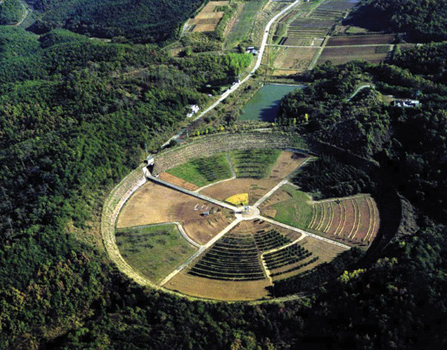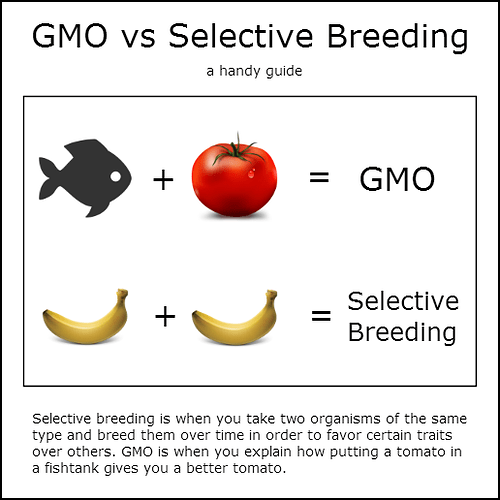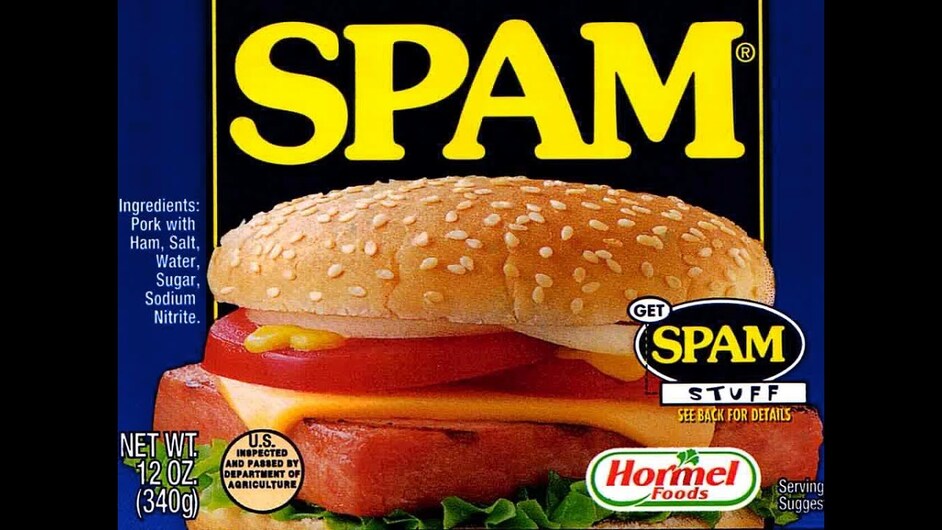Compare the Definitions:
Genetically Modified
Mostly true. I’ve seen fields switched over to soy and fields left to grass (Dept of Natural Resource land) that will have corn/maize scattered around it the following year. As it’s pollinated by the wind and needs a certain density for good pollination it will be wiped out in the following year(s). I don’t know about the seeds rotting part, but the corn cobs will dry out on the cob and animals will spread the seeds. And the corn/maize in farm fields are hybrids so the next year’s crop aren’t true. I don’t think that’s true of heirloom popcorn (I have a friend who will find out this year.) But really, most cultivated varieties of food plants won’t do well without being gardened/farmed. A few exceptions to the rule I’m sure.
There are too many brain cells in this forum for its own good. LoL
I have a friend who is an executive chef and his favorite line is, “it takes as much work to make food taste bad as it does to make it taste good.” (Followed by swearing when directed at somebody who made it taste bad.)
look i’m sorry, but none of this is correct:
“all of our produce and plants” are not gmo. yes, they’ve been selectively bred. no, it’s not the same thing, not even remotely.
sweet corn is kind of close, though, as all the modern sweet corn descendants come from, i believe, one of the nuclear gardens (bury a source of radiation, plant crops in circles around it, see if you get anything interesting).
lots of crops are like that though - a number of things have been bred to not grow seeds. and many if not most tree fruit rarely seem to breed true, so they can only be propagated by clones and grafts.
this is wrong, it’s descended from teosintes (yes this is a group of fairly closely related grasses but they’ve all been interbred so it’s disingenuous to suggest that this is equivalent to not knowing what plant corn comes from). thanks to cheap dna sequencing it’s actually quite easy to generate phylogenetic trees, especially when the original organism is still alive. there are actually only about five genetic regions that separate the wild grasses from the primitive maizes.
my favorite semi-related corn fact is that some of the original proto-maizes have evolved because of weeding pressure. that is, cultivators of Z mays (corn) want to weed their gardens, so the wild grasses have evolved to look more like corn as they grow, to maximize their fitness. it’s pretty wild stuff.
one of the few remaining gamma gardens is in japan:

Yes, they know the genetic family they were bred from, but there is not a particular species that you can point at and say, “That’s wild corn.” That was my point.
no, you’re using terms incorrectly. they know the genus the plants came from, and they’ve done genetic analyses and interbreeding to suggest it’s a mix of like two.
inasmuch as corn is “just” big grass, this is also incorrect.
you would be justified in calling any species in Zea a wild corn, or at the very least, a proto-corn.
More than happy to stand corrected. I certainly don’t have to be, or pass for, an expert on every subject.
The wikipedia article does state opinions vary and where I’ve read about it in the popular literature something similar is generally said. How a teosinte or two made the jump to maize is a bit more puzzling than most staples. You’ve stated your pedantic need for correctness, but I’m not bothered by kennethclapp’s statements here.
That teosintes develop maize-like tendencies from weeding is very interesting so I am glad I learned about that.
You’re right. I’m bad to misuse words at times 
I guess my main point was more along these lines:
Teosintes are critical components of maize evolution, but opinions vary about which taxa were involved. According to the most widely held evolutionary model, the crop was derived directly from Z. m. parviglumis by selection of key mutations;[2] but in some varieties up to 20% of its genetic material came from Z. m. mexicana through introgression [3] (From the same article)
It’s also interesting how the development seemed to encompass the entire Western Hemisphere.
According to Matsuoka et al., the available early maize gene pool can be divided into three clusters:
An Andean group, that includes the hand-grenade-shaped ear types and some other Andean maize (35 plants);
All other South American and Mexican maize (80 plants);
U.S. maize (40 plants)
Also, some other intermediate genomes, or admixtures of these clusters occur.
According to these authors, “The maize of the Andes Mountains with its distinctive hand grenade-shaped ears was derived from the maize of lowland South America, which in turn came from maize of the lowlands of Guatemala and southern Mexico.”[2]
there’s no need to be snide, and we both know that’s what that is.
yes, i’m given to pedantry, but listening to people talk about GMOs and making other incorrect assumptions about food and genetics is honestly possibly my biggest pet peeve. i started out my career in molecular micro and i really hate seeing bad information because other people read it and use it to make informed decisions about the things they put in their bodies. additionally, “opinions vary” is not a good argument in this instance. this isn’t like there’s huge debate about the wild differences. when wiki puts “opinions vary” for this, they’re talking about slight differences, not “hey guys i think corn evolved in australia.”
yes! and quite common in all of these developments around the world. people started growing things, and as they moved around the continent, they brought their food and knowledge with them, so it spread; obviously all of these grasses had been far ranging previously, but as they were all pretty obviously related, the humans figured out that they could take advantage of that.
i think my biggest issue with this specific corn discussion - to the extent that they are different, the differences we’re talking about here are very slight. they just happen to have an outsized impact on phenotype.
Just for the record I don’t consider the early development of corn as a GMO. I do know the difference between purposeful cross breeding and selective breeding and purposefully messing with a plants genetic sequence in the lab. The only point I was actually trying to make is the development of Corn or Maize is just one of the evidences that pre-Columbian cultures were more advanced than what modern textbooks and popular beliefs tend to show. That was all ![]()
Btw, this comment flies in the face of what has been the common perception of pre-Colombian cultures. It’s only been in the last few decades that the realization of an intercontinental roadway that linked many if not most of the major cultures in the New World. It was the work of agricultural historians (too tired to remember the real term) researching corn that helped drive some of the research ![]() One of my passionate areas in which I tend to annoy people is History
One of my passionate areas in which I tend to annoy people is History ![]() which means I can be pedantic and boring all at the same time!
which means I can be pedantic and boring all at the same time!
Edit: Nutritional Anthropologist ![]() finally popped into my head.
finally popped into my head.
trust me, it won’t be.
yesssssssssssss
totally agree; i first heard about him from that old penn and teller show.
My coworkers have a weekly SPAM ritual, and they were excited at the idea of my engraving our corporate logo into it. After all the good points made about lasering food (ash particles contaminating it, etc.) as well as the smell of burning SPAM ![]() I’ve decided that instead of lasering it directly, I’m going to create a special, food-safe stamp with our corporate logo so they can stamp the SPAM before they toast it. I’ll use the same putty and process @dan used in Feeling a little gelty.
I’ve decided that instead of lasering it directly, I’m going to create a special, food-safe stamp with our corporate logo so they can stamp the SPAM before they toast it. I’ll use the same putty and process @dan used in Feeling a little gelty.
…and how do I post a YouTube embed on here?
Put the URL (the actual YouTube page) on its own line and Discourse gives the view

